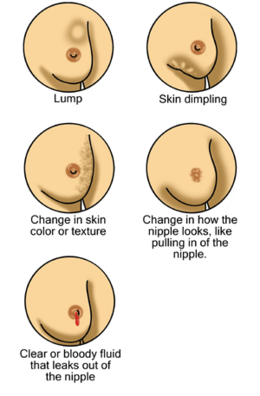Breast disease
| Breast disease | |
|---|---|
| Other names | Breast problems |
| Specialty | Gynecology |
Breast diseasesmake up a number of conditions. The most common symptoms are abreast mass,breast pain,andnipple discharge.[1]
A majority of breast diseases are noncancerous.[2] Although breast disease may be benign, or non-life threatening there remains an associated risk with potentially a higher risk of developing breast cancer later on.[3]
Tumor
[edit]
A breast tumor is an abnormal mass of tissue in thebreastas a result ofneoplasia.A breast neoplasm may bebenign,as infibroadenoma,or it may bemalignant,in which case it is termedbreast cancer.Either case commonly presents as abreast lump.Approximately 7% of breast lumps are fibroadenomas and 10% are breast cancer, the rest being other benign conditions or no disease.[4]
Phyllodes tumoris a fibroepithelial tumor which can be benign, borderline or malignant.
Breast cancer
[edit]Breast cancer is cancer of the breast tissues, most commonly arising from the milk ducts. Worldwide, breast cancer is the leading type of cancer in women, accounting for 25% of all cases.[5]It is most common in women over age 50.
Signs of breast cancer may include alumpin the breast, a change in breast shape,dimplingof the skin, fluid coming from the nipple, a newly inverted nipple, or a red or scaly patch of skin.[6]Diagnosis may also be made when the cancer is asymptomatic, throughbreast cancer screeningprograms, such asmammograms.Outcomes for breast cancer vary depending on the cancer type,extent of disease,and person's age.[7]Survival rates in thedeveloped worldare high,[8]with between 80% and 90% of those in England and the United Statesalive for at least 5 years.[9][10]
Fibrocystic breast changes
[edit]Also called: fibrocystic breast disease, chronic cystic mastitis, diffuse cystic mastopathy, mammary dysplasia
Infections and inflammations
[edit]These may be caused among others by trauma, secretory stasis/milk engorgement, hormonal stimulation, infections or autoimmune reactions. Repeated occurrence unrelated to lactation requires endocrinological examination.
- bacterial mastitis
- mastitis from milk engorgement or secretorystasis
- mastitis
- chronicsubareolar abscess
- tuberculosisof the breast
- syphilisof the breast
- retromammaryabscess
- actinomycosisof the breast
- duct ectasia syndrome
- breast engorgement
Other breast conditions
[edit]- Mondor's disease
- Paget's disease of the breast
- nipple discharge,galactorrhea
- breast cyst
- mastalgia
- galactocoele
See also
[edit]References
[edit]- ^Salzman, B; Fleegle, S; Tully, AS (15 August 2012). "Common breast problems".American Family Physician.86(4): 343–9.PMID22963023.
- ^"MedlinePlus: Breast Diseases".Archivedfrom the original on 2016-07-05.Retrieved2018-03-21.
- ^"Non-Cancerous Breast Conditions | Benign Conditions".www.cancer.org.
- ^Page 739 in:Mitchell, Richard Sheppard; Kumar, Vinay; Abbas, Abul K.; Fausto, Nelson (2007).Robbins Basic Pathology.Philadelphia: Saunders.ISBN978-1-4160-2973-1.8th edition.
- ^World Cancer Report 2014.World Health Organization. 2014. pp. Chapter 1.1.ISBN978-92-832-0429-9.
- ^"Breast Cancer Treatment (PDQ®)".NCI.23 May 2014.Archivedfrom the original on 5 July 2014.Retrieved29 June2014.
- ^"Breast Cancer Treatment (PDQ®)".NCI.26 June 2014.Archivedfrom the original on 5 July 2014.Retrieved29 June2014.
- ^"World Cancer Report"(PDF).International Agency for Research on Cancer.2008. Archived fromthe original(PDF)on 20 July 2011.Retrieved26 February2011.
- ^"SEER Stat Fact Sheets: Breast Cancer".NCI.Archivedfrom the original on 3 July 2014.Retrieved18 June2014.
- ^"Cancer Survival in England: Patients Diagnosed 2007–2011 and Followed up to 2012"(PDF).Office for National Statistics.29 October 2013.Archived(PDF)from the original on 29 November 2014.Retrieved29 June2014.
Further reading
[edit]- Irshad, A.; Ackerman, S. J.; Pope, T. L.; Moses, C. K.; Rumboldt, T.; Panzegrau, B. (2008). "Rare Breast Lesions: Correlation of Imaging and Histologic Features with WHO Classification1".Radiographics.28(5): 1399–1414.doi:10.1148/rg.285075743.PMID18794315.
